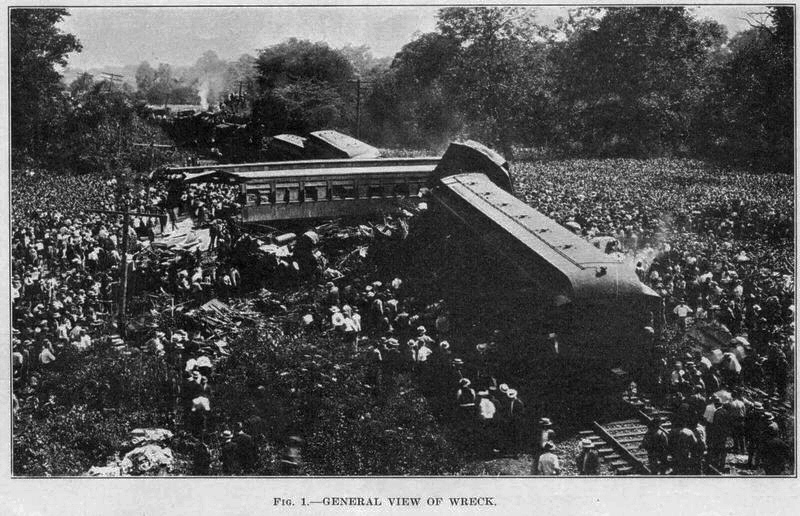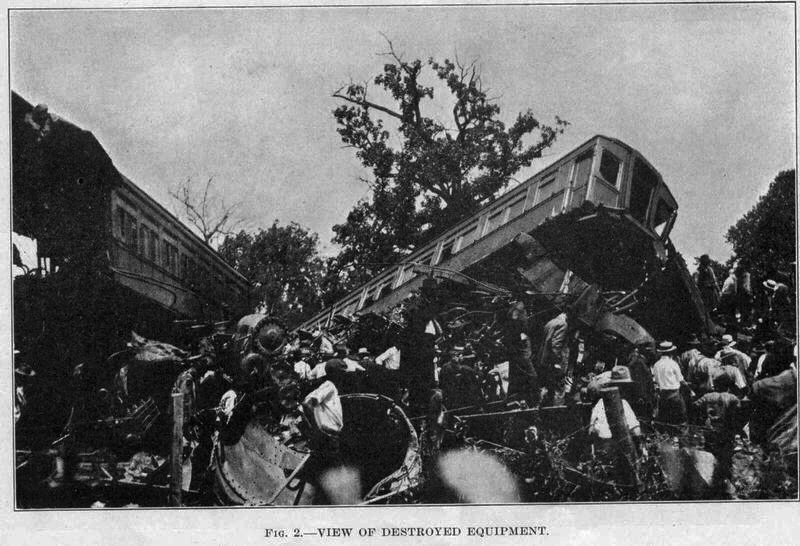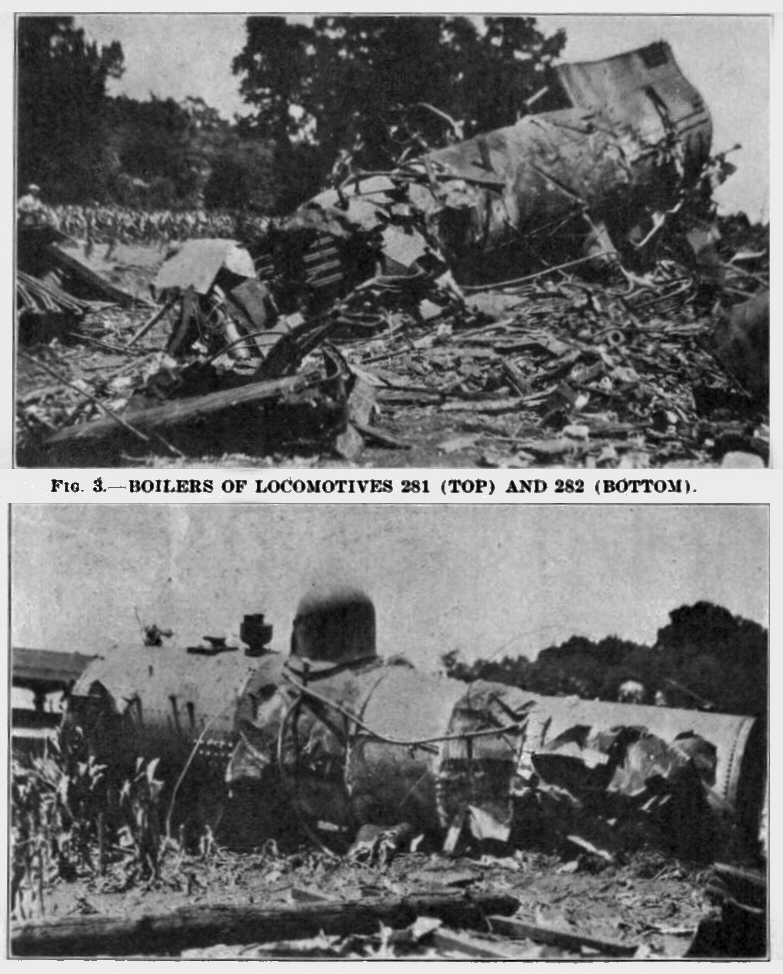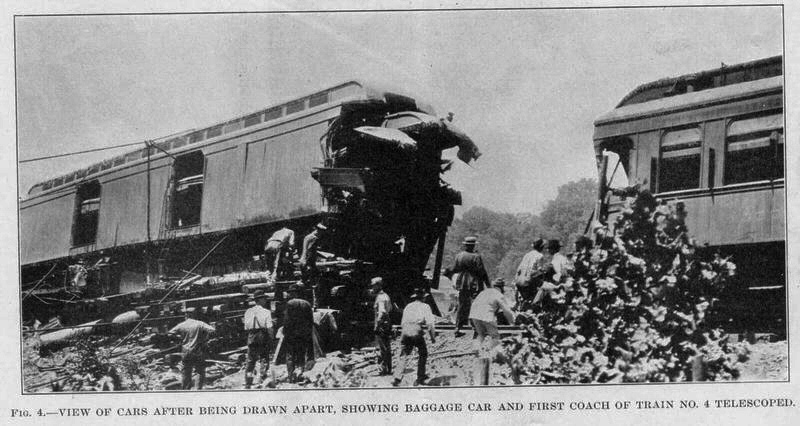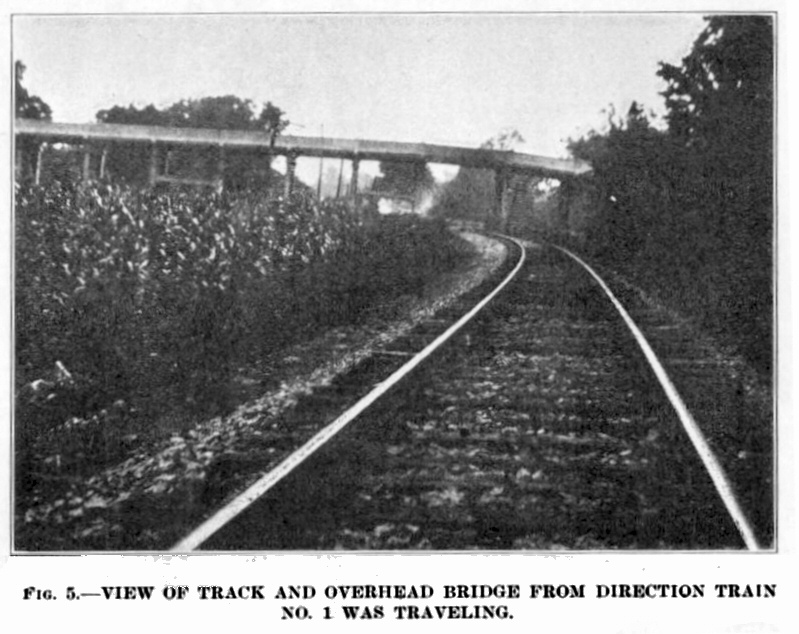
Nashville, TN July 9, 1918 |
|
|
INTERSTATE COMMERCE COMMISSION. REPORT OF THE CHIEF OF THE BUREAU OF SAFETY COVERING THE INVESTIGATION OF AN ACCIDENT WHICH OCCURRED ON THE NASHVILLE, CHATTANOOGA & ST. LOUIS RAILWAY AT NASHVILLE, TENN., ON JULY 9, 1918. AUGUST 16, 1918. To the Commission: On July 9, 1918, there was a head-end collision between two passenger trains on the Nashville, Chattanooga & St. Louis Railway at Nashville, Tenn., which resulted in the death of 87 passengers and 14 employees. and the injury of 87 passengers and 14 employees. After investigation the following report is submitted: That part of the Nashville division of the Nashville, Chattanooga & St. Louis Railway upon which this accident occurred is a single-track line over which trains are operated by time table and train orders, there being no block system in use. Between Nashville and Shops, a distance of 2.5 miles, it is a double-track line, and at Shops there is an interlocking plant which controls all main line switches there. The accident occurred about half way between Shops and Harding, located 2.5 and 6.8 mils, respectively, from the station at Nashville, and within the city limits of Nashville. The trains involved in this accident are shown on the time table as southbound passenger train No. 1 and northbound passenger train No. 4, but in the vicinity of the point of accident, southbound trains run practically north and northbound trains practically south. Soutbound trains are superior to northbound trains. Train No. 4 is scheduled to leave Nashville at 7 a.m., and train No. 1 is scheduled to arrive at Nashville at 7.10 a.m. Train No. 1 consisted of locomotive 281, one baggage car and five coached of wooden construction, one Pullman sleeping car of steel construction and one Pullman sleeping car with steel underframe and ends, in the order named, and was in charge of Conductor Tucker and Engineman Lloyd. It was enroute from Memphis to Nashville, being operated over the Louisville & Nashville Railroad from Memphis to McKenzie, and the remainder of the distance over the Nashville, Chattanooga & St. Louis Railway. It left McKenzie at 3 a.m., passed Bellevue, 12.6 miles from Nashville, at 7.09 a.m., 30 minutes late, and at about 7.20 a.m. collided head on with train No. 4 at a point about 4.5 miles from Nashville, while running at a speed estimated at about 50 miles an hour. Fig. 1 is a general view of the wreck. Train No. 4 consisted of locomotive 282, one combination mail and baggage car, one baggage car and 6 coaches, in the order named and all of wooden construction, and was in charge of Conductor Eubank and Engineman Kennedy. At Nashville the crew received train order No. 29 reading as follows: No. 4 engine 282, hold main track, meet No. 7, Eng. 215, at Harding. No. 1 has engine 281. This train left Nashville at 7.07 a.m. 7 minutes late, passed Shops at 7.15 a.m., and collided with train No. 1 at a point about 2 miles beyond Shops while running at a speed estimated to have been about 50 miles an hour. The engineman and firemen of both trains were killed. Locomotive 281 was derailed on the west side of the track, the boiler being stripped of cab, machinery and appurtenances, and came to rest in an upright position at an angle of about 45 degrees with the track; it is shown in Fig. 3. Its frame and all machinery were practically demolished. The baggage car was completely demolished. The first coach lay crosswise the track, the combination car of train No. 4 being driven into its side near the center and its rear end torn completely end to a depth of 12 or 15 feet. The second coach was derailed and its forward end went down the bank and rested on the front end of boiler of locomotive 281 and its rear and rested on the roadbed on top of the frame and other parts of locomotive 281, its forward end being badly broken and damaged. The third coach remained on the roadbed with its forward end jammed against the rear of the second coach; the rear trucks of this car and the four following cars were not derailed. All of this equipment was on train No. 1 Figs. 2, 3 and 4 are views of the destroyed equipment. Locomotive 282 was derailed to the east side of the track, the boiler thrown from the frame and entirely stripped of all machinery and appurtenances and stopped about parallel with the track, the entire locomotive except the boiler being demolished, as shown by Fig. 3. The forward half of the combination car was demolished by coming in contact with the first coach of train No. 1. The baggage car was completely telescoped with the first coach to its rear, both cars remaining upright, but were practically destroyed, as shown by Fig 4. The end of the second coach was demolished for a distance of 6 or 8 feet and partially telescoped with the rear end of the coach ahead of it. The three rear cars of train No. 4 were not derailed and only slightly damaged. Approaching the point of accident from Harding, the track is straight for about 1,800 feet, then there is a 1-degree curve to the right about 2,100 feet long, then a tangent about 1,100 feet long, then a 1-degree curve to the left about 1,300 feet long, then a tangent about 2,000 feet long, then a 2-degree curve to the right about 1,500 feet 2,000 feet long, then a 2-degree curve to the right about 1,500 feet long, the collision occurring about 900 feet in on this curve. The track just described is laid on a fill and a descending grade varying from 0.3 per cent to 0.7 per cent to within about 350 feet of the point of collision. and then the grade is practically level for about 2,000 feet. About 300 feet south of the point of collision, there is an over head highway bridge over the track and just south of the bridge there are heavy woods on the right hand side of the track. Approaching the point of accident from the direction of Shops, the track is straight for approximately 4,000 feet, then there is a 3-degree curve to the left about 2,200 feet long, then a tangent about 1,000 feet long which leads to the 2-degree curve on which the collision occurred. The grade descends from 0.7 per cent to 1.3 per cent to within about 1,650 feet of the point of collision, and is practically level the remainder of the distance. Between Shops and the point of collision there are several cuts, one of which ends about 300 feet before reaching the point of collision, and has a maximum depth of 15 feet. This cut, the overhead highway bridge and the curve upon which the accident occurred made it practically impossible for the enginemen to see approaching trains is indicated by Fig. 5. The weather at the time was clear. Dispatcher Phillips stated that when he missed train order No. 29 for train No. 4 to meet train No. 7, he added the information that train No. 1 was being hauled by locomotive 281, it being the custom to advise the crew of train No. 4 of the engine number of train No. 1 in this manner to aid then in identifying that train, and also to advise them that that train had not arrived at Shops. He said trains Nos. 1 and 4 are scheduled to pass on the double track between Nashville and Shops, and in case train No. 4 arrived at Shops before train No. 1, train No. 4 is expected to remain at Shops until train No. 1 arrives, unless the crew receives authority to proceed, train No. 1 being the superior train. He said there was no train register at Shops. Conductor Eubank of train No. 4 stated that before leaving the station at Nashville, he received a train order advising that engine 281 was hauling train No. 1 and he delivered a copy of that order to Engineman Kennedy who read it back to him. He remarked to Engineman Kennedy that "No. 1 must be some late this morning, but I dont believe the mail is going to delay us so he will have to change that meeting point to Vaughns Gap," and from the remarks passed between them he supposed Engineman Kennedy knew their train was liable to be detained at Shops to meet train No. 1. Conductor Eubank stated that he read the train order to the train porter just as his train was leaving the station and shortly thereafter, and while his train was still on the double track, he delivered the order to the flagman and told him to look out for train No. 1. He said he knew train No. 1 had not arrived at Shops when he left Nashville and kept that train in mind. He was busy collecting tickets and before reaching the end of the double track, he heard a train pass his train on the opposite track, which he assumed was train No. 1, although he could not see it on account of the car in which he was riding being crowded. He said it took all his time and attention to collect the tickets before the next regular stop, and he was depending upon the engineman, fireman, porter and flagman to look out for train No. 1, as was his custom, and stop at Shops in case they did not pass that train. He stated that his train was running at a speed of about 45 miles an hour when he felt the application of the air brakes, followed immediately by the collision. He said he considered Engineman Kennedy careful man of good habits and when talking to him before leaving Nashville, he was apparently in good spirits and normal condition. Flagman St. Clair of train No. 4 stated that when his train left Nashville, he was riding on the rear end and when it reached Shops he went forward, asked Conductor Eubank for the train orders, received them, but the conductor said nothing to him about looking out for train No. 1. He said a switch engine with 8 or 10 cars passed his train between Nashville and Shops, moving in the opposite direction, but saw no other trains. He said he had made but two trips as a flagman on a freight train, and this was his first trip as a passenger train flagman. Conductor Tucker of train No. 1 stated that his train was running about 30 minutes late, and at a speed of 50 or 60 miles an hour, when the collision occurred, but he felt no application of the air brakes. He said he had received no orders concerning train No. 4, but it being an interior train, he expected it to wait at Shops until his train arrived. Conductor Riggle, who alternated with Conductor Eubank on train No. 4, stated that he always kept train No. 1 in mind after leaving Nashville, and made it a special point not to pass Shops unless he personally knew that that train had arrived; on several occasions he had waited Shops until that train arrived. He said he depended upon the flagman, porter, and engine crew to identify train No. 1, but would not permit his train to pass Shops unless they advised him it had arrived, or he saw it. Engineman Winford, who alternated with Engineman Kennedy on train No. 4, stated that it was sometimes necessary to wait at Shops until train No. 1 arrived. He said he usually finds the signals at Shops set for movement to the single track, but he always waited until the arrival of train No. 1, it being his understanding that the interlocking signals gave his train to rights over superior trains beyond Shops. Operator Johnson stated that he went on duty at Shops at about 7.06 a.m. or 7.07 a.m., and train No. 4 passed the tower there about 7.15 a.m. at a speed of about 25 miles an hour. At that time he did not know whether train No. 1 had arrived, and did not examine the train sheet to see if it had; the first notice he had of its nonarrival was when he saw it was not entered on the train sheet. He said he reported the passage of train No. 4 promptly to the dispatcher, who told him to try and stop that train, as it should have waited for train No. 1, and he sounded the emergency air whistle in an effort to attract the attention of the crew of that train, which was then about a train length away, but the signal was not heeded. When train No. 4 approached the tower, the signal was in the proceed position, but he said that did not give it a right to proceed against train No. 1. He said nothing was said about train No. 1 when he took charge of the tower that morning. Traveling Engineer Fahey stated that he considered Engineman Kennedy a very careful man, well posted on the rules, and one who adhered strictly to them. He said he bad observed engineman passing Shops upon the operators word that superior trains had arrived, and as a result, the superintendent issued bulletin No. 1268 under date of May 28, 1918, reading as follows: Understand some engineers on outbound trains are passing the Shops without any definite information as to whether superior trains have arrived, other than to ask operator at Shop tower. This must be discontinued. Superior trains must either he registered before the northbound train depart or be identified by some member of the crew of the superior train, meet the superior train between Nashville and the Shops or have an order at the Shops stating that the superior has arrived. NOTE. -- See that train dispatchers understand this and have the orders ready at the Shops so they can be handed on to the outbound trains. This accident was caused by train No. 4 occupying the main track on the time of a superior train, for which Engineman Kennedy and Conductor Eubank were responsible. Rule 83 of the operating rules of the Nashville, Chattanooga & St. Louis Railway provides in part as follows: A train must not leave its initial station or any division, or a junction or pass from double to single track, until it has been ascertained whether all trains due which are superior or of the some class, have arrived or left. The evidence indicates that Engineman Kennedy and Conductor Eubank had been running on train No. 4 for several years and before leaving Nashville on the morning of the accident they had talked about train No. 1 and knew that it had not arrived, although it was due there at 7.10 a.m., three minutes after their train departed. As Engineman Kennedy was killed in the collision, no evidence could be secured to determine what caused him to overlook train No. 1. Conductor Eubank apparently relied wholly upon the other members of the train crew to identify train No. 1 and allowed his train to pass from double track to single track at Shops without making any effort to ascertain whether train No. 1 had arrived. His statement that he was busy collecting tickets and that he passed a train in the yards between Nashville and Shops, which he did not see, but assumed was train No. 1, can not be considered a valid reason for overlooking of failing to identify that train. His first duty was to provide for the safety of his train and see to it that it did not pass from double track to single track before train No. 1 had arrived; and particularly in a yard where switching movements are constantly being made, he was extremely negligent in assuming that a passing train was No. 1 without seeing it and without being notified of its identify by some member of his crew who had seen it. While the operating rules of the company required that a train must not pass from double to single track "until it has been ascertained whether all trains due, which are superior, or of the same class, have arrived or left," no means were provided by the company to enable employees to secure definite information of that character. That responsible operating officers were well aware of the conditions existing at Shops, as well as the fact that train employees were not strictly adhering to the requirements of the rule, is evidenced by the superintendents bulletin No. 1268, issued last May. It appears that bulletin contemplated orders would be issued and delivered to outbound trains at Shops giving notice of superior trains which had arrived, but no practice of this nature was in effect. The custom of merely notifying outbound train crews of the number of the locomotive hauling an opposing superior train was utterly inadequate as a safeguard, for under the practices followed, the train crew was required to observe and correctly read the number of the passing locomotive under all conditions of weather and traffic. The records show that during the month of June, on average of 23 trains daily were operated into and from Nashville over this division, and the number of yard movements materially increased the density of traffic between Nashville and Shops. Under these circumstances, it is absolutely essential to safety that some means be provided for supplying to outbound crews definite information regarding opposing superior trains, as, for example, by the maintenance of a train register at Shops, or by issuing orders to outbound trains at Shops giving definite notice of the arrival at that point of superior trains which had not arrived at Nashville at the time of departure of the outbound trains. This accident would have been prevented, beyond question of doubt, by a properly operated manual block system on the single-track line north of Shops, for which all necessary appliances and facilities were already available. The time table indicates that between Nashville and Hickman, Ky., a distance of approximately 172 miles, there are 27 train-order offices, of which 14 are continuously operated. On this line there are 4 schedules passenger train in each direction, and a total of 12 schedules freight trains. With this volume of traffic, and in view of the universally recognized features of increased safety afforded by the block system, there can be no valid excuse for the failure or neglect on the part of the railroad company to utilize existing facilities for the purpose of operating a block system on that line. It is to be noted that all the cars of both trains, except the two sleeping cars on train No. 1, were of wooden construction, and six of these wooden cars were entirely destroyed. This accident presents a more appalling record of deaths and injuries than any other accident investigated by the Commission since the ancient-investigation work was begun in 1912. Had steel cars been used in these trains, the toll of human lives taken in this accident would undoubtedly have been very much less. All of the employees involved were experienced men, with the exception of the flagman, with good records, and at the time of the accident the crew of train No. 4 had been on duty 52 minutes, and the crew of Train No. 1, 9 hours and 52 minutes. Respectfully submitted. W. P. BORLAND, Chief, Bureau of Safety. FIG. 1- GENERAL VIEW OF WRECK.
FIG. 2 - VIEW OF DESTROYED EQUIPMENT.
FIG. 3 - BOILERS OF LOCOMOTIVES 281 (TOP) AND 282 (BOTTOM).
FIG. 4 - VIEW OF CARS AFTER BEING DRAWN APART, SHOWING BAGGAGE CAR AND FIRST COACH OF TRAIN NO. 4 TELESCOPED.
FIG. 5 - VIEW OF TRACK AND OVERHEAD BRIDGE FROM DIRECTION TRAIN NO. 1 WAS TRAVELING.
|
|
|
Source: Investigations of Railroad Accidents 1911 - 1966 |
NC&StL Preservation Society, Inc. is in no way
affiliated with the NC&StL Railway or any of it's successors.
As a non-profit entity, NCPS presents these pages to the public purely
for educational and historic interest.
Return
to top
| Home | About
Us | History | Engine
576 | Cities | People
| Model
Railroading
Membership | Merchandise
| Links | Site
Map | Contact Us | Copyright | Privacy
Policy
We can't do it without your help!
If you have information
you would like to contribute,
we would appreciate
hearing from you.
(c) 2003, NC&StL Preservation Society
